Beginning in Vienna, Austria at Kahlenberg
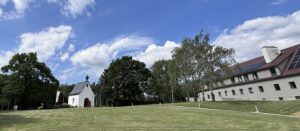
From June 14 – 16, 2024, leaders of the Schoenstatt Family Movement from the Czech Republic, Hungary and Austria met at the Schoenstatt Center on Kahlenberg in Vienna. It was a starter meeting, according to Ingeborg and Richard Sickinger, movement leaders of the Schoenstatt Movement Austria, “to discern together what the Blessed Mother wants.” Together with Father Heinrich Walter (ISch) and Sister Gertrud-Maria Erhard, they were responsible for this weekend. “Is there a common vision for us as leaders in the Schoenstatt Movement that is transnational? Do we need Kentenich courses that deal specifically with leadership according to Father Joseph Kentenich and from which each of our countries can benefit?” Key questions like these shaped the program for the weekend.
A snapshot of two newcomers to the Schoenstatt Family Movement, Germany, who were present as guests.
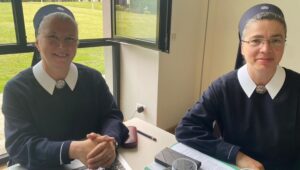
Who are we?
The weekend started with a potpourri of country presentations on Friday, in which each group gave an insight into the Schoenstatt Movement in their country. In just a few minutes, everyone was immersed in exciting and very different stories of how Schoenstatt began in each country.
The beginning of the Schoenstatt Movement in the Republic of Czech goes back to the year 1934. Through the diocesan priest Fr. Štěpánek, several priests and lay people discovered Schoenstatt and made the covenant of love with the Mother Three Times Admirable of Schoenstatt in 1939. Petr Zbornik, who is from the Czech Republic, related:
“During the communist government, some Schoenstatt Sisters of Mary were interrogated and imprisoned. Many of them lived unrecognized as consecrated women in various places in our country. Although they were not allowed to speak about Schoenstatt, Schoenstatt continued to spread. Paradoxically, the political situation in the Czech Republic has greatly helped Schoenstatt’s development.”
Today, the Schoenstatt Movement is most widespread around the shrine in Rokole and in Brno, the second largest city in the Czech Republic.
“Only 35 years in existence, the Schoenstatt Movement in Hungary is relatively young,” stated Tamás Dabóczi.
Mr. and Mrs. Gódány, together with Father Tilmann Beller, were the Schoenstatters who started the movement in Hungary. As early as 1967, Róbert and Rita Gódány, who were then living in Vienna, had a meeting with Father Kentenich in Schoenstatt. They belonged to the first circle of Schoenstatt families in Austria. In the 1980s, during the communist era, they left Austria with their children and returned to their home country of Hungary to devote themselves entirely to building up Schoenstatt. The first Schoenstatt Family Conference in Hungary took place in 1985 – five families were present. Today there are 17 family conferences a year at their newly built Schoenstatt Center alone, in addition to the other conferences of the Movement. The first Hungarian shrine was consecrated in Óbudavár in 2005.
In the history of Schoenstatt in Austria, it all began with three Schoenstatt Sisters of Mary who came to two parishes in Vienna in 1972. A little later Sister M. Elmengard could work exclusively for the Schoenstatt Movement. In 1973, Father Tilmann Beller came. The Schoenstatt Movement flourished. In 1976, the first wayside shrine was established. Six years later Austria had its first Schoenstatt Shrine on Kahlenberg in Vienna. In the years that followed, the branches of the Schoenstatt Movement in Austria grew. In 1989, the first group of the Schoenstatt Federation of Families started and in 1991 the Academy for Family Pedagogy began, which now has 5,000 graduates and married couples.
With the renovation and expansion of the Schoenstatt Center on Kahlenberg, the national ideal – the “Holy City” – shines anew and is central.
These initial impressions were followed by other aspects, such as an insight into the country’s ideals and leadership structures, and a multifaceted picture of the movement in each country emerged before our eyes.
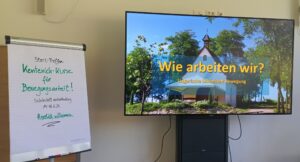
With this foundation, the work began on Saturday. The focus changed to the current situation in the individual countries with the following questions:
– How do we work?
– How do new people join?
– Which of Father Kentenich’s principles do we apply?
– How do people continue to grow in Schoenstatt and what are the decisive points?
– What challenges are we facing?
After an intensive day filled with input and lots of discussion and exchange, Mr. and Mrs. Sickinger summed it up:
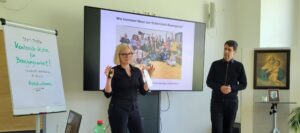
“We realized there are very similar challenges and longings in our countries and also the desire to have good leaders
in and for Schoenstatt.”
This applies to the work now and is, above all, one of the central questions of the future for Schoenstatt. It is precisely this concern which the idea of the Kentenich courses addresses.
Father Kentenich’s know-how in Schoenstatt movement work must be passed on.
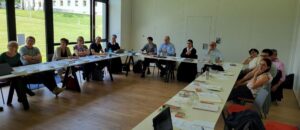
The conviction was reinforced in the subsequent speeches and also in unspoken aspects that characterized the atmosphere throughout the day: We are on the right track with the Kentenich courses. Father Kentenich’s know-how in movement work must continue and be passed on. The aim is to “elicit the expertise of laypeople,” as it was said at one point, and above all to achieve this: “As married couples, we can and should be pastoral agents – active agents,” as Pope Francis puts it. “It is a calling of its own and you can sense that God has great plans for the families.”
Leadership of a special kind: leading with and through currents
On Sunday morning, our founder himself had the floor. We delved into the art of working by means of streams and read a text from a conversation between Father Kentenich, Father Haag and Hans Kulgemeyer in Milwaukee.
“… not just a clarification of an idea, this must become a real movement of life to which the heart is attached … until a vital attitude (is) created. Then, afterwards, you can move on from this basis.” It depends on “the extent to which an idea is firstly gleaned from the needs and aspirations of the community and whether and to what extent it is held on to with determination and nurtured again and again. (JK, see. Milwaukee, USA, November 20, 1964)
Text passages and thoughts were repeated in turn. Everyone in the group was familiar with working with currents and yet something was created. Something came together. Answers were awakened and hearts were touched.
Going into training
At the end of the last session, there was a clear vote:
We will bring to life the idea of Kentenich courses for movement work.
A flipchart was filled with a concrete proposal regarding format and time frame. Focus areas were identified and a team was formed in order to develop the next steps and a concept.
Community spirit and gratitude filled the room and continued to resonate in the concluding Sunday Holy Mass. During the liturgy, the view to the shrine, the center of the beautiful, newly renovated Schoenstatt Center on Kahlenberg, was unobstructed. Faces also radiated satisfaction. The heart of the matter, i.e. the focus of these days, seems to have been met.
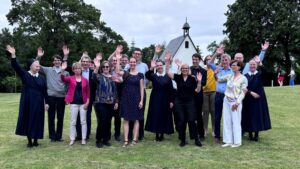
“There is nothing more beautiful and no task more important to which the Blessed Mother can call us than to lead and guide Schoenstatt,”
that was a motivating final word. And now it’s time to go into training.
